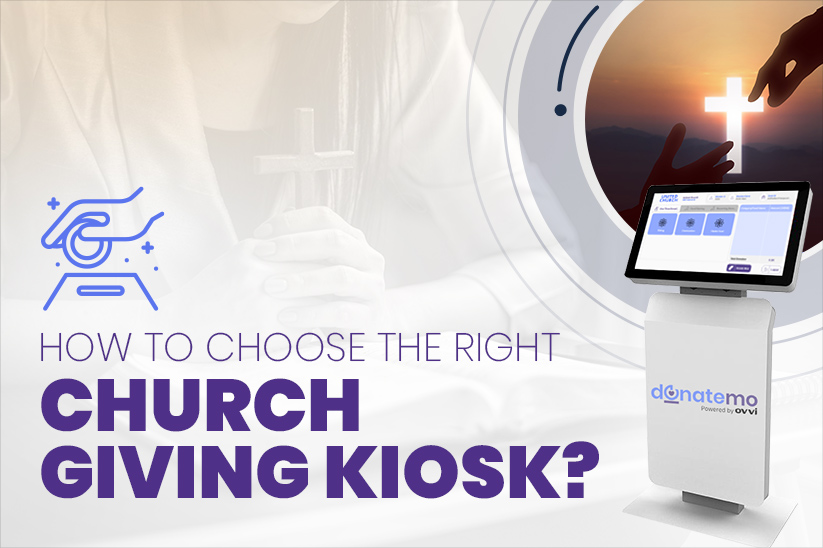
How to Choose the Right Church Giving Kiosk?
“Quick Summary” Churches are one of those religious entities that serve society through various causes and campaigns. But to continue this great work, they, too, need funds. Just because the churches are not involved in any commercial activity, donations from their patrons are their only income source.
A major share of the collected funds is generously used for the welfare and well-being of society. At the same time, a small amount is reserved for the administration and maintenance of the church.
Sticking to conventional requests for individual donations is a tough nut to crack. This is where church-giving kiosks come into play. Buying any giving kiosks for churches won't serve the purpose. When your church is unique, you must consider reading this blog before investing in a kiosk for giving.
What is a Church Giving Kiosk?
Let’s first understand what a church-giving kiosk is.
When you listen to the word kiosk, the first image that comes to your mind is a small device with an interactive display screen. A kiosk is usually small and has a digitally powered display facing the donor. Kiosks are excellent devices to facilitate commercial transactions or display information to the public.
Business owners install kiosks in high-traffic areas or locations with good footfalls to provide information or offer self-servicing options. Switching to kiosks will enhance your store's functions and ensure great customer experiences. The same is true for churches. A kiosk can easily share the necessary information about various causes and suggest multiple options to help donors confidently donate.
With multiple requirements, companies have come up with many types of kiosks. Let’s discuss each one.
The Types of Giving Kiosks
Your purpose will define the type of kiosk to be used. Kiosks these days come in varied forms to meet your requirements. Primarily, kiosks are segregated into two main categories. The “Interactive Kiosks” and “Non-interactive Kiosks.” This section discusses each category in detail to offer you the required clarity.
Interactive Kiosks
As the name suggests, interactive kiosks are best for interaction with your customers and donors. Because of their interactive nature, they generate perfect engagement with the users. The interactive kiosks find their applications at retail outlets, railway stations, airports, multiplex theatres, malls, and large grocery stores.
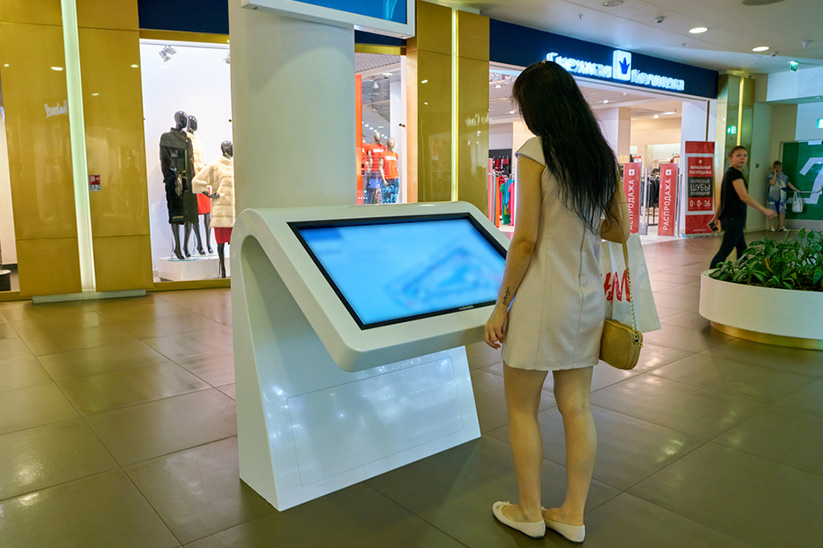
You may also find these kiosks outside busy fast-food outlets. Customers can place their orders, make payments, and receive a printed bill and a receipt acknowledging their orders. Interactive kiosks help visitors reach their destination with accurate navigation and wayfinding signs for buildings spread over a larger area and with complex interiors.
Wayfinding Kiosks
Wayfinding kiosks are your best friend. They help you navigate unknown spaces and reach your desired location with their wayfinding feature. Wayfinding kiosks offer ample information in the form of directories, maps, and directional displays.

Modern-day wayfinding kiosks are equipped with touch screens. Shoppers can use these kiosks to search or explore the map. Wayfinding kiosks are often found in malls and big box stores where customers risk getting lost, losing their orientation in your space, or being unable to find what they are searching for without assistance.
Typically, wayfinding kiosks are equipped with touch-screen features. Shoppers can use them to search maps and other navigation in. malls and huge stores. Wayfinding kiosks often find their application on the premises.
Self-Service Kiosks
Yet another popular and highly interactive type of kiosk is a self-service kiosk. The self-service kiosk is popular amongst retailers and customers alike. Retail outlet owners can save on staff recruitment.
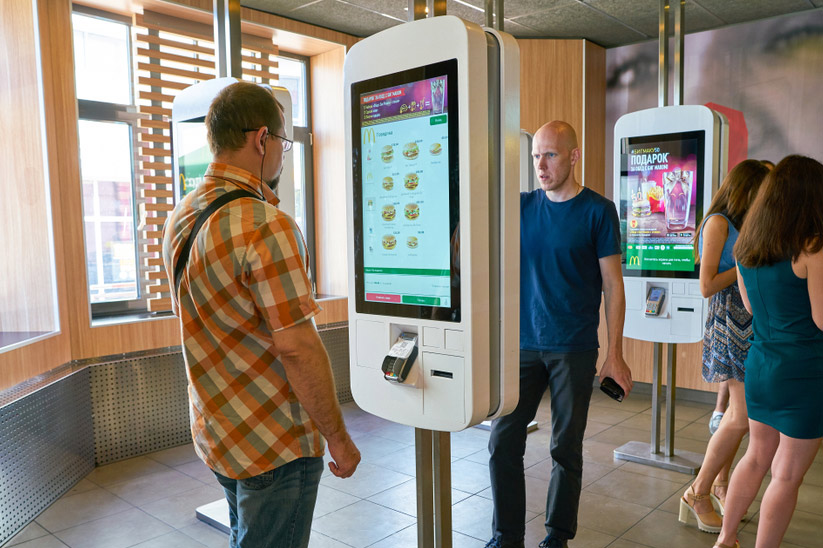
In contrast, shoppers can skip the queue and get the information, select the items, place orders, and pay with digital payment options. The self-service kiosk cuts down on the customer’s time and allows him complete control over what he buys. If the UI is simple and fluid, your customer will enjoy the best buying experience.
You can choose the right church giving kiosk and install it at your church premises as a church administrator. As this will be a self-servicing kiosk, imagine the donation experience your supporters will receive, ultimately enhancing their trust in the church leadership and the causes.
Shoppable Kiosks
You'll encounter huge secured vending machines at airports, malls, and railway stations. You'll see smaller items like cosmetics, canned beverages, and hair and beauty products. Big brands generally install such shoppable kiosks outside their premium outlets.
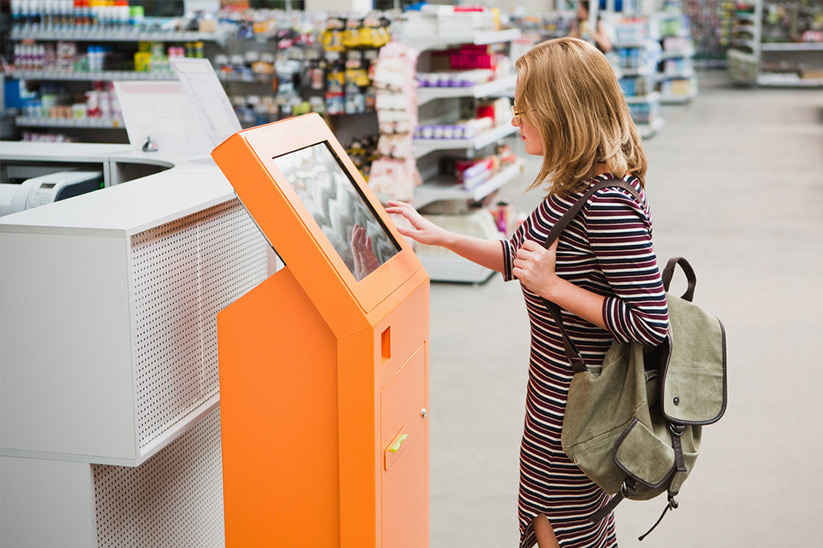
The shoppable kiosks offer the convenience of purchasing branded products and accessories and boost your brand awareness and value. These kiosks are more than just kiosks; they are brand builders and ambassadors.
The only downside for the shoppable kiosk is its price. Because it is installed and connected to large vending machines and works on complex algorithms, you might have to assign a special budget for this kiosk. Hence, you must be vigilant and take appropriate steps when you choose the right church giving kiosk.
On the other hand, churches have reasons to use a church giving kiosk within their premises. Besides the regular giving facility, supporters can scroll through a detailed page offering faith-based accessories. Such kiosks will add another source of income for the church.
Internet Kiosks
The main purpose is to augment customer experiences and provide internet access to the public. You will find kiosks at airports, hotel lobbies, apartments, Multiplexes, and hospitality setups. Internet kiosks may also be able to swipe credit cards and pay bills.

Non-Interactive Kiosks
Some kiosks need to be non-responsive. They are required only to display the received information. The non-interactive kiosks offer a superb platform to advertise. Running ads regularly on these kiosks can build awareness and generate engagement. Those interested may visit the outlet for a live demo or purchase products.

Churches can display their prayer schedules and forthcoming events on such kiosks. They can also run videos or flash images of a recently completed social event. The donors would feel happy and proud to witness their donations being used for a great cause.
Informational Kiosks
Despite being non-interactive, the informational kiosk has always proved its significance. Business owners and retailers use this kiosk extensively. Besides presenting the guests with important information, the informational kiosk is used to display new product information, forth-coming discounts, and stock clearance sales and also aid in general store operations.
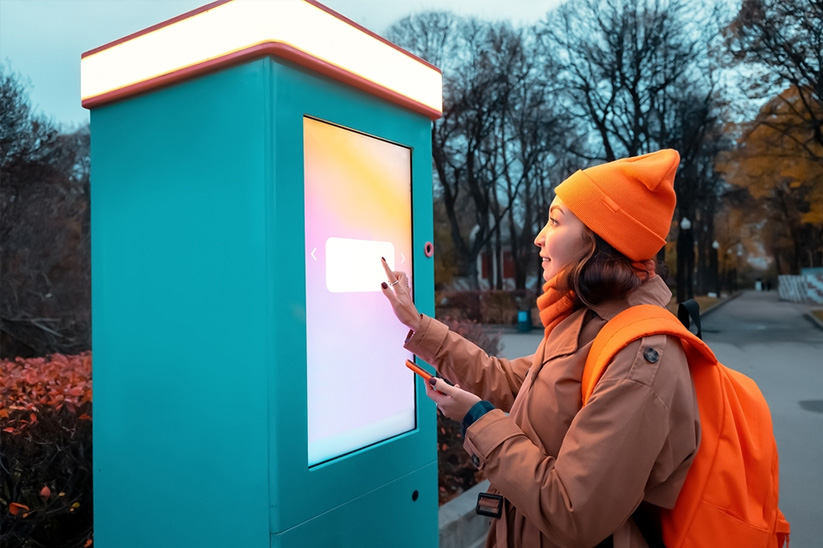
If you have a larger business premise, you can have one installed at the entrance of each section, demonstrating the product details within that section. Going beyond your store, you can install such informational kiosks in and around your neighborhood. Other purposes might be besides this, yet informational kiosks help you spread your brand awareness.
Product Kiosks
Did you ever encounter a roadside kiosk that displayed a fantastic image of a newly launched product at your favorite store? The graphics and the media displayed were so excellent that they lured you into visiting that store.
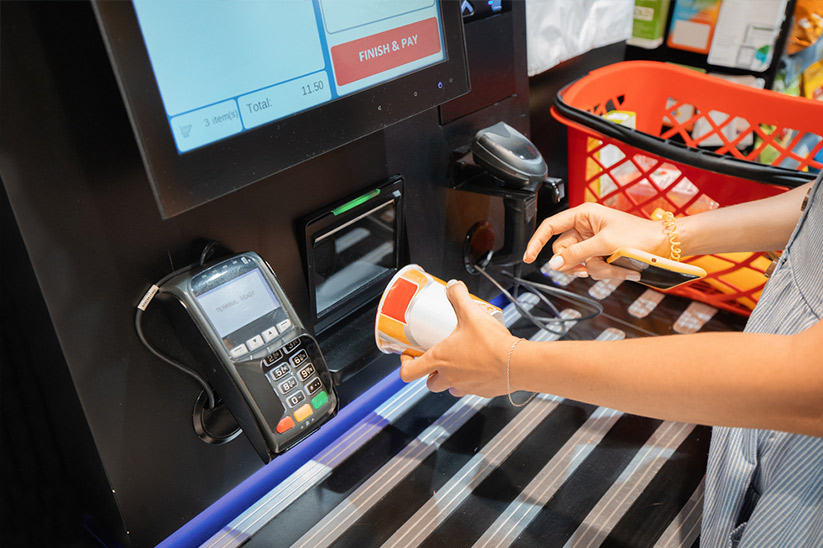
This is the strength of a product kiosk. You will see such kiosks on busy roads, walkways, and in proximity to large branded outlets. A few chains of restaurants love to display popular cuisines crafted by their master chefs. Product kiosks are one of the most impactful yet silent marketers for brands.
Promotional Kiosks
As the name suggests, promotional kiosks are great for promoting your products or informing visitors about an upcoming event. The correct location for the promotional kiosk is within your retail outlet or close by. The best thing to happen when you use a promotional kiosk is spreading awareness. Guests get instantly attracted to such kiosks, increasing sales for your business.
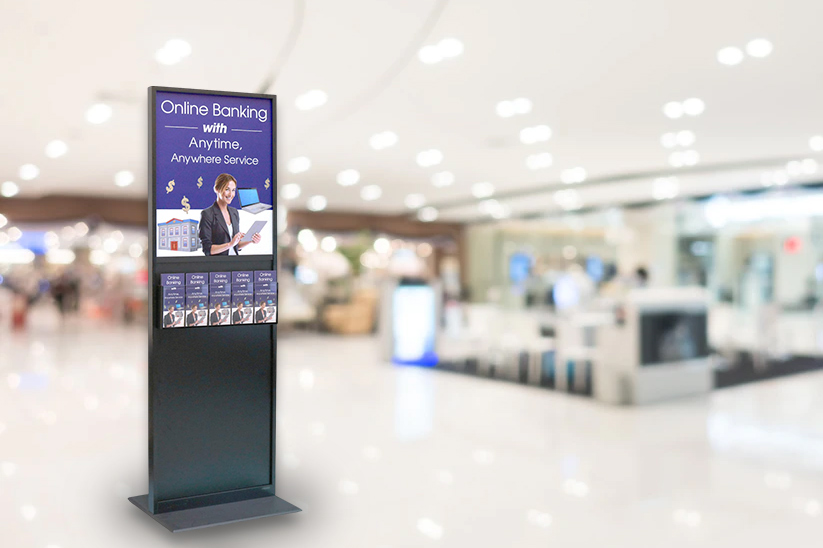
Ensure to maintain the right distance between the product and its advertisement in the kiosk. The prime concern is that visitors don’t need to waste time searching for the product after viewing its promotion. Never mix two product categories in one spot, as it might create a distraction, and the customer may drop the idea of purchasing either of the products.
By now, you would have gained enough understanding about kiosk types.
So let’s dive into the features to consider while buying a church-giving kiosk.
Features to Consider While Buying a Church-Giving Kiosk
Technology has become integral to our lives. Similarly, technology has simplified the fundraising process and made it accessible to the common person. To stand up to the latest developments and innovations, organizations and churches have accepted the significance of digital fundraising and have started accepting donations and tithes digitally.
With kiosks accepting donations through debit/credit cards and other digital forms, they have compelled the churches to upgrade their infrastructure. With this upgradation, churches have also earned the freedom to accept donations in multiple forms through digital kiosks at various locations.
If your church authorities also wish to make giving kiosks a part of its infrastructure, then considering the following features will help you make an informed decision.
Before installing any giving kiosk, the church must have a clear idea about the reasons to use a church giving kiosk within their premises, as a general-purpose kiosk will not benefit the church. The church leadership must ensure to personalize kiosks to reflect their brand.
- The kiosks’ appearance should match the color of the church.
- The kiosk should carry the church or non-profit’s logo.
- The kiosk must have access to and display the church’s marketing content. These could include signage and banners.
- The kiosk must display the images and video content of the previous and existing campaigns, highlight the achievements, and acknowledge the contributions of the top donors. This information will help boost your nonprofit organization and develop an emotion of trust within all who believe in your church.
There is a major benefit to personalizing the kiosks with your brand. Your donors will start trusting the church and its administration. Once trust and belief build up, engagement with your donors will be smooth. Branding your kiosks will improve the aesthetic value and boost the patron’s confidence assuring him that his donation is being used for a genuine purpose.
Considering the church's and society's needs, churches can undertake different campaigns, each with a unique cause and purpose to fulfill.
Similarly, your kiosk should be capable of adapting to these changing causes and campaign types. An essential feature is to consider a brand whose kiosks can perform with the same efficiency, despite different situations.
- Should accept all credit cards.
- Can adapt and be usable in every situation. When moving out of the church, opt for a portable giving kiosk for churches. Portable kiosks are lightweight, easy to carry, and ready to accept donations anywhere once powered.
- Flexible donation amounts. Suppose your kiosk allows you to amend your donation amount (without much complexity) to match your location and situation. In that case, you can engage with the community and optimize the purpose of your donation.
You must consider reading our blog, facts about church giving kiosk solutions, to update yourself on the fact about church-giving kiosks.
Your kiosk’s flexibility will ensure better engagement and brighten the success ratio of fundraising events.
Why would any donor contribute if he has the slightest double about the security of his financial transactions? Hence, to earn the trust of your donors, the church administration must ensure proper end-to-end security of the donors' financial details and transactions. The church must invest in a kiosk that applies multiple parameters to create a secure environment for the donor.
Before finalizing the kiosk supplier, the church must ensure that its products are PCI-compliant.
His giving kiosks for churches must support 128-bit encryption. This means the transaction data travels in an encrypted form through a 128-bit secured tunnel. This data cannot be deciphered anywhere except by the receiving server. The encryption must work on strong mathematical algorithms to preserve security.
His giving kiosks for churches must support tokenization. Tokenization is a procedure similar to encryption. The difference is tokenization generates a random code or token which substitutes the donor's information making it impossible to break into the security of the information.
When it comes to security, never compromise. Always insist the vendor updates you on managing and protecting the client’s sensitive information. Price shouldn’t be a concern when security is prime.
Moving around with a large and bulky kiosk, especially at a fundraising event, is neither practical nor advisable. Such bulky devices will deplete you of your operational freedom. The best solution is to carry a portable mobile kiosk visible to the community members. When you place this device on a table, members will easily spot it and recognize its purpose.
Because of its size, transportation is never an issue with a portable mobile kiosk. This kiosk leaves plenty of room for other marketing material. You can have campaign-specific and general marketing materials placed across the table space. You may also showcase small souvenirs and gift them to your donors.
Irrespective of the purpose, people always love and appreciate simpler processes and user-friendly interfaces. Similarly, the donation process must be enjoyable and lucid to help your church engage with the donors in achieving its purpose.
Suppose a kiosk with elegant looks offers a lengthy and complicated donation process encapsulating multiple validation steps. Would you prefer to use such a kiosk? Obviously, no! Similarly, donors wish to have something simple and less laborious. When your church decides to own a simple and user-friendly kiosk, your donors will love to donate handsomely. If the process is self-explanatory, you can avoid having a volunteer or staff member.
Criteria to confirm if the kiosk is user-friendly.
- The device must complete the process in a few steps.
- The device supports all card types and transactions.
- The device offers self-explanatory steps for easy understanding.
- The device doesn’t flash any (distracting) ads during the donation process.
From the church’s perspective:
When a church member is assigned to manage an outdoor donation campaign, checking if he can set up and adjust the device effortlessly is mandatory. You might need access to the vendor's technical team in major cases. Can you manage the show on your own? If all these sounds complicated, the church leadership must choose the right church-giving kiosk keeping donors and staff members in view.
Your kiosk must respond to inputs from the donors. When a donor begins his interaction with the kiosk, it should welcome him. It can be in the form of visual text or voice. The kiosk must appreciate the donor's charity act at every step.
A short voice-guided instruction will help generate engagement. Voice-guided instructions can also aid visually-impaired individuals.
If you want your donors to have a memorable experience, always build a unique and surprising element into your kiosk. Your kiosk vendor can explain you the various aspects and help you choose the right church giving kiosk.
One must understand a donor's emotional attachment while donating to a cause or performing an act of tithing. If you want your donors to feel the same about your church giving-kiosk, your kiosk must offer a similar experience (electronically) as the tithing ritual.
When your kiosk offers the supporters an incomparable and memorable experience, there is no looking back. These supporters will be the church’s brand ambassadors, happily spreading God’s message to all.
What good is a kiosk if it doesn’t offer reports and quality insights? The reports from your kiosks help you build strategies that work to achieve goals. When determining your kiosk's ideal donation amount, location, campaign, and overall fundraising strategy, a kiosk that tracks specific metrics can turn the tables.
What should your kiosk track?
- The average size of the donation:
You must calculate the average donation to arrive at an amount the donors are comfortable with. In this way, you can optimize your fundraising efforts. - Date and time of the donation:
Determining the donors' contribution duration gives you access to donors' habits. You can also estimate the best period to receive maximum donations. - Where was the kiosk used:
You must consider tracking the places where your kiosks were used. This exercise proves useful in determining the right place when you have multiple kiosks to work with.
Kiosk Benefits You Should Never Miss
There are many players in the market offering various kiosk brands. These kiosks prove useful only if they offer your donors the right benefits of online giving for churches Now that we have discussed the types of church-giving kiosks and the features to look for before buying one for your non-profit, learning about the benefits of investing in kiosks for your church is essential. The below-mentioned benefits will help you determine if your investment is worthwhile.
Kiosks are smart digital devices that can fill up gaps in your operational environment. Using their logic and intelligence, they can manage any pre-defined task efficiently. Kiosks are capable of automating your store or outlet. Kiosks can manage the customer flow, complete the ordering process, provide important information to visitors, or manage navigation and wayfinding within the premises. You name a task, and your kiosk can digitally achieve it, streamlining your overall operation.
Kiosks can remove the pain and add smiles to your customers’ faces. When your operation functions systematically, your customer will enjoy the best shopping or donating experience.
When your church allows:
- The freedom and convenience of donating through self-servicing kiosks.
- Check the campaigns working for the best social causes.
- Print donation receipts for tax obligations on their own.
It can save them time and add smiles to their life. A self-servicing kiosk gives them the satisfaction of performing great deeds close to their hearts.
Without relying on external assistance, your patrons can access important information the church offers. They can check out the next upcoming events, schedules for prayer meetings, and the essential facts revealing the difference that the church brought to its followers and society.
Hiring skilled and talented staff has become more daunting than ever. Post-COVID, organizations have been highly impacted by the lack of skilled talents. In a few instances, business owners are compelled to hire less talented staff and pay higher wages.
If your non-profit is in the same scenario, it's time to embed the right church-giving kiosk into your infrastructure. We don’t ask you to retrench your existing staff, but if you generate new vacancies at your organization, consider whether a kiosk can fulfill its duties and responsibilities. If your experiment turns out to be positive, you have nothing to lose. Additionally, a kiosk can perform multiple tasks (without asking for a paid vacation or salary hike.)
Kiosks are not a replacement for the human workforce but an essential bridge to fill possible staffing vacuums while keeping the processes smooth, intact, and efficient.
Kiosks deliver awesome results if part of a controlled and concise processing chain.
Interactive kiosks can be your best bet if you plan to add kiosks to your workforce pool. The only resources kiosks require are electricity and internet, yet you save ample money, time, and effort.
While your kiosks can answer the donors’ queries, the church administration can save a good deal on labor costs and focus on promoting major campaigns and socio-economical causes.
When the church decides to bring a change, it will, beyond all doubt, positively impact society.
Like any other employee within your organization, the kiosk, too, needs your attention, focus, and care. Placing it anywhere won’t make sense. If you do so, your investments will start flowing down the drain. Hence, place your kiosks at strategic locations where potential donors can see and access them easily. This a simple yet highly effective strategy your church must adopt to widen its reach where more prospective patrons await to join the congregation.
Conclusion
With the advancement of technology, people have found better ways to achieve their purposes and add comfort and convenience to their daily routines. The same stands true for donations. Looking at this scenario and the future of digitalization, more and more non-profits and churches have started switching to technology.
Church leadership has started investing in kiosks to meet the giving needs of their donors. If your non-profit still believes in the conventional methods of accepting donations, it's time to evolve and embrace digital technology. Choosing the best church-giving kiosk will open new avenues and brighter possibilities for growth.
